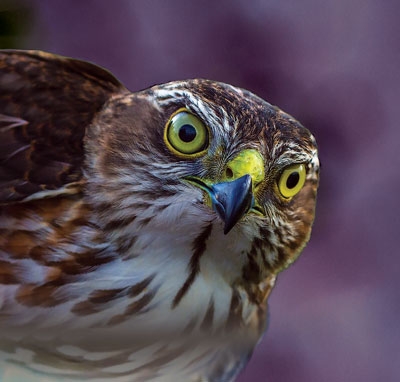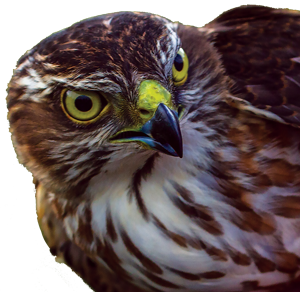The Japanese Sparrowhawk
A testament to design—and natural selection?

The Japanese Sparrowhawk is an impressive bird. With its keen eyesight, short wings, and long tail, it is ideally suited to flying quickly through dense forests to catch its prey. The barred colouring on its underparts makes it hard to detect in this habitat, leaving its dinner unsuspecting until it is too late. In short, this bird is well designed to be a highly efficient woodland hunter.1
The Japanese Sparrowhawk is a raptor, or bird of prey, and is diurnal, i.e. active in the daytime (as opposed to nocturnal, active at night). It is 29–34 cm (~1 ft) long, and females are larger than males. Most of its prey consists of small birds. However, it will also feed on larger birds, small mammals and even insects.
Interestingly, this sparrowhawk will keep leftover food for later—a behaviour called caching. The bird will find suitable clumps of twigs and leaves up in the branches of a tree. It will carefully place the prey on top and press down firmly with its beak and feet.2 It collects and eats the food later when live prey is not available. Caching is particularly important around breeding time when it needs more food, and also coming into colder weather when food is scarce.
The Japanese Sparrowhawk lives in Central and Eastern Asia. It breeds in areas from China through to Siberia, and then heads south to spend the winter in Indonesia and the Philippines.
When ready to breed, this sparrowhawk will build a nest of leaves and twigs, generally in coniferous trees. This is built close to the trunk and is fairly well hidden. The pair incubates 2–5 eggs for about a month. After hatching, it takes another month for the offspring to develop the feathers and wing muscles to enable them to fly on their own.3 This is known as fledging.
Many features have to work together to make the Japanese Sparrowhawk a successful hunter. The combination of relatively short wings and a long tail enable the bird to manoeuvre during flight. A short wingspan enables it to fly in dense woodland. The long tail adds stability. Add to this the fact that each wing-tip feather can be controlled independently. This reduces turbulence, improves control, and makes for a bird that is very well designed for fast aerial pursuits! 4
Imagine one part of this process not working properly. The sparrowhawk might be very fast through the forest, with great eyesight and camouflage—but a short tail would result in collisions with trees.
It’s tempting to see this near-perfect suitability for woodland hunting as being the result of specific design for that purpose. But it may instead be the result of a general good design in an original raptor kind, with ‘built-in variation potential’. We can reasonably presume that all raptors descended from a few original created kinds (perhaps only one, even). The original kind that was the sparrowhawk’s ancestor may have been designed with certain characteristics useful for all environments, such as phenomenal eyesight and speedy flight, but sufficient genetic flexibility to allow subsequent ‘finetuning’ to different environments.
Thus, for example, those raptors with genes permitting better agility would be more able to survive and breed in a woodland environment, and thus more likely to pass on these genes than those not already so equipped. Consider as an analogy the fact that all people normally have the brown skin-colouring chemical, melanin. Those with the genes to have more of this sunscreen chemical in their skin will do better than those with less in equatorial environments of high sunshine. So natural selection results in the people in such areas being likely to have darker skin. The environment has ‘finetuned’ the characteristic, not created it (the genes were always there).
In the same way, earlier raptor populations would have had genes for both short and long tails, and short and long wingspans, and so on, each able to be favoured by different environments. Such adaptation by natural selection (a factual process5 first described by creationists6) acts on characteristics already there, fitting each descendant group more closely to its environment. Yet evolution entails selection, acting on chance mutations, creating the entire package of incredible biological machinery—not just in raptors, but every living thing.
The chances of mutations (genetic accidents) producing all of the changes just when needed during the alleged evolution of flight, for instance, are extremely remote.7
Also, given that just a few of these changes occurring without the others would actually be a disadvantage, they would simply be eliminated by natural selection. The design explanation, especially coupled with natural selection’s proven capacity for ‘finetuning’ to fit the environment, makes much more sense.
Designed to kill?
But why would God have designed such a highly effective killing machine? Doesn’t that go against the nature of a God who declared that His creation was ‘very good’ (Genesis 1:31)? The Bible makes it clear that, in the beginning, there was no death and suffering; these only came about because of sin. Even the birds and the beasts were not originally carnivores. The original creation truly was ‘very good’ (Genesis 1:30–31).8
We know that the sparrowhawks can eat insects, which in biblical terms are not living creatures or nephesh chayyah.9 These birds, along with all the other carnivores, only became meat-eaters after the Fall. There are a number of animals that appear to be well-designed hunters, but which actually prefer plants. One of these is the Palm Nut Vulture, a raptor which uses its sharp, curved beak and large talons to feast on palm nuts, as the name suggests.10
More generally, we can recognize that all of the death and bloodshed that we see around us is not part of God’s original plan.
We look forward to a day when “death shall be no more, neither shall there be mourning, nor crying, nor pain anymore, for the former things have passed away.” (Revelation 21:4)

Dinosaur-to-bird evolution?
Many evolutionists believe that dinosaurs called raptors were the ancestors of the raptor birds we know today.1 There are a number of problems with this idea however, and even some evolutionists don’t agree. John Ruben from Oregon State University is one who disputes that any dinosaurs evolved into any of the bird groups. “We’re finally breaking out of the conventional wisdom of the last 20 years, which insisted that birds evolved from dinosaurs and that the debate is all over and done with,” he said. “This issue isn’t resolved at all.”2,3
Not surprisingly, fossil findings have not produced any reliable intermediate forms between birds and any sort of reptiles—dinosaurs or otherwise.
- See www.answers.com/article/874134/raptor-birds, accessed 6 December 2016.
- Bird-from-dinosaur theory of evolution challenged: Was it the other way round? sciencedaily.com, 10 February, 2010.
- Chapter 4 of Sarfati, J., Refuting Evolution, Creation Book Publishers, Powder Springs, GA, 2012, creation.com/refuting-evolution-chapter-4-bird-evolution.
References and notes
- See: Japanese sparrowhawk (Accipiter gularis), planetofbirds.com, 27 August, 2011. Return to text.
- See: The caching behaviour of Japanese Lesser Sparrowhawks Accipiter gularis during the breeding season, Japanese Journal of Ornithology, 43(1):32–35, 1994; doi: 0.3838/jjo.43.32. Return to text.
- Ref. 1. Return to text.
- See Chanting-goshawks, goshawks , sparrowhawks, hawks, oiseaux-birds.com. Acc. May, 2014. Return to text.
- Sarfati, J., The fact of natural selection, creation.com/guliuzza, 16 November 2014. Return to text.
- Bergman, J., Did Darwin plagiarize his evolution theory? J. Creation 16(3):58–63, 2002. Return to text.
- To read more about bird flight, see Sarfati, J., Fancy flying from advanced aeronautics, Creation 29(1):37–39, 2006; creation.com/fancy-flying. Return to text.
- For a deeper discussion of how the many attack/defence structures in living things came about after the Fall, see Chapter 6 of CMI’s The Creation Answers Book, available as a free pdf at creation.com/cab6. Return to text.
- Pitman, D., Nephesh chayyāh, creation.com/nephesh-chayyah. “Nephesh chayyāh” is the Hebrew term translated “living creatures” in Genesis. Return to text.
- Catchpoole, D., The bird of prey that’s not, Creation 23(1):24–25, 2000, creation.com/no-bird-of-prey. Return to text.









Readers’ comments
Comments are automatically closed 14 days after publication.